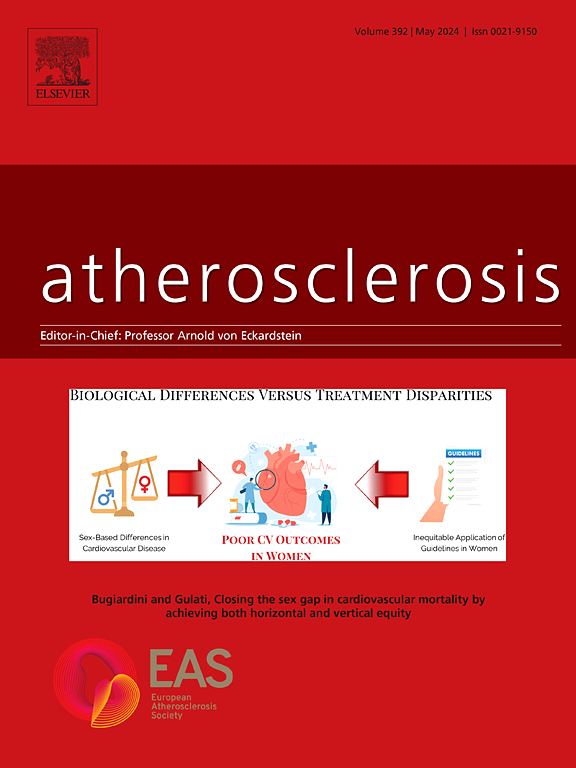NAD+ boosting increases atherosclerotic plaques and inflammation in Apoe knockout mice
IF 4.9
2区 医学
Q1 CARDIAC & CARDIOVASCULAR SYSTEMS
引用次数: 0
Abstract
Background and aims
NAD+ (nicotinamide adenine dinucleotide) is a cosubstrate of the sirtuins (SIRT) that are activated upon caloric restriction. Supplementing NAD+ precursors such as nicotinamide riboside (NR) has been reported to extend life span and combat metabolic syndrome through pan-sirtuin activation in mice. Notably, sirtuins compete with poly (ADP-ribose) polymerase (PARP)1 and CD38 for NAD+. Supplementing NAD+ precursors did not improve cardiovascular outcome in the AIM-HIGH trial. Recently, the terminal NAD+ metabolite 4PY (N1-methyl-4-pyridone-3-carboxamide) was reported to increase inflammation and to be associated with cardiovascular risk. We aimed to investigate whether NR provides atheroprotection.
Methods
8-week-old male apolipoprotein E (Apoe) knockout mice were fed for 12 weeks a high-cholesterol diet supplemented with three NR doses: NR-, NR+, and NR++. RAW264.7 mouse macrophages and bone marrow macrophages were stimulated with oxLDL and NR.
Results
NR++ enhanced plaque lesions in aortic sinus sections and increased plasma levels of TNFα, IL-6, and LDL-cholesterol. Liver and plasma NAD+ concentrations remained unchanged, but the downstream metabolite 4PY increased. In liver lysates, SIRT1 and lipoprotein receptors were decreased and CD38 increased in NR++; cleaved PARP1 and total PARylation decreased upon NR supplementation. In oxLDL-treated macrophages, high NR levels increased CD38 and CD86 expression.
Conclusions
High-dose NR supplementation in mice did not decrease but increase both aortic plaque lesions and systemic inflammation. These effects may be mediated by increased CD38 expression in macrophages, with NAD+ metabolism shifted from sirtuins towards CD38 and PARP1 pathways. Caution should be applied with presumed NAD+ boosters in patients with atherosclerosis.

在Apoe基因敲除小鼠中,NAD+增加会增加动脉粥样硬化斑块和炎症
背景和目的snad +(烟酰胺腺嘌呤二核苷酸)是sirtuins (SIRT)的一种共底物,在热量限制时被激活。据报道,在小鼠中补充NAD+前体如烟酰胺核苷(NR)可以通过泛sirtuin激活延长寿命和对抗代谢综合征。值得注意的是,sirtuins与聚(adp -核糖)聚合酶(PARP)1和CD38竞争NAD+。在AIM-HIGH试验中,补充NAD+前体并没有改善心血管结局。最近,NAD+末端代谢物4PY (n1 -甲基-4-吡啶酮-3-carboxamide)被报道可增加炎症并与心血管风险相关。我们的目的是研究NR是否提供动脉粥样硬化保护。方法8周龄载脂蛋白E (Apoe)基因敲除雄性小鼠,在高胆固醇饮食中添加NR-、NR+、NR++三种剂量,饲喂12周。结果snr++增强了主动脉窦切面斑块病变,提高了血浆TNFα、IL-6和ldl -胆固醇水平。肝脏和血浆NAD+浓度保持不变,但下游代谢物4PY升高。在肝裂解物中,NR++的SIRT1和脂蛋白受体降低,CD38升高;在补充NR后,裂解的PARP1和总PARylation减少。在氧化低密度脂蛋白处理的巨噬细胞中,高NR水平增加CD38和CD86的表达。结论大剂量NR对小鼠主动脉斑块病变及全身炎症均无明显影响。这些作用可能是由巨噬细胞中CD38表达增加介导的,NAD+代谢从sirtuins转向CD38和PARP1途径。动脉粥样硬化患者应谨慎使用推定的NAD+增强剂。
本文章由计算机程序翻译,如有差异,请以英文原文为准。
求助全文
约1分钟内获得全文
求助全文
来源期刊

Atherosclerosis
医学-外周血管病
CiteScore
9.80
自引率
3.80%
发文量
1269
审稿时长
36 days
期刊介绍:
Atherosclerosis has an open access mirror journal Atherosclerosis: X, sharing the same aims and scope, editorial team, submission system and rigorous peer review.
Atherosclerosis brings together, from all sources, papers concerned with investigation on atherosclerosis, its risk factors and clinical manifestations. Atherosclerosis covers basic and translational, clinical and population research approaches to arterial and vascular biology and disease, as well as their risk factors including: disturbances of lipid and lipoprotein metabolism, diabetes and hypertension, thrombosis, and inflammation. The Editors are interested in original or review papers dealing with the pathogenesis, environmental, genetic and epigenetic basis, diagnosis or treatment of atherosclerosis and related diseases as well as their risk factors.
 求助内容:
求助内容: 应助结果提醒方式:
应助结果提醒方式:


